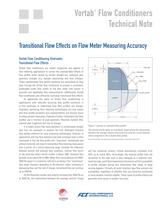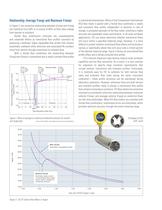 Website:
FCI Fluid Components International
Website:
FCI Fluid Components International
Catalog excerpts

Vortab® Flow Conditioners Technical Note Transitional Flow Effects on Flow Meter Measuring Accuracy Vortab Flow Conditioning Eliminates Transitional Flow Effects Vortab flow conditioners are widely recognized and applied in flow metering applications to correct the unpredictable effects of flow profile shifts caused by limited straight-run, upstream pipe geometry changes (e.g. damper positioning) and load changes. These unpredictable flow profile variations are neutralized as they pass through the Vortab flow conditioner to present a consistent, predictable outlet flow profile to the flow meter that results in accurate and repeatable flow measurements. Additionally, Vortab flow conditioners also efficiently neutralize transitional flow effects. To appreciate the value of Vortab flow conditioning in applications with naturally occurring flow profile variations, it is first necessary to understand how flow profiles can change. Engineers specifying flow metering technologies are very aware that flow profile variations and unpredictability will directly result in measurement inaccuracy. Engineers further understand that flow profiles are a function of pipe geometry, Reynolds number (Re), internal pipe roughness and rate of change. It is widely known that many diameters of uninterrupted straight pipe runs are necessary to produce the fully developed turbulent flow profiles preferred by many measuring technologies. However, in applications with low flow detection and wide turndown what is often overlooked is that the flow profile also “transitions” dramatically and without correction can result in tremendous flow metering inaccuracies over a portion of a critical measuring range. Consider the difference between laminar and turbulent flow conditions. Laminar flow occurs at low velocities where the Re number is below 2000. Turbulent flow typically occurs above Re of 4000. When flow occurs between the 2000-4000 Re region it is commonly referred to as being in the “transitional” flow range. However, depending on the direction, either increasing or decreasing flow, and the rate of change, transitional flow can continue up to 7000 Re. As the Reynolds number and velocity increase from 2000 Re up to 4000 Re, the relationship between the average velocity V (avg) and the centerline velocity V (max) dramatically increases from 50% up to nearly 80%. Accordingly, the velocity profile from the centerline to the pipe wall is also changing at a dramatic rate. Insertion type, point flow measuring instruments will be susceptible to profile changes during this transitional flow range to large varying degrees. Virtually all point insertion type flow sensors are susceptible, regardless of whether they are centerline positioned or have variable insertion depths. These types of profile effects are generally more acute in smaller line sizes. Figure 1. Laminar vs. turbulent flow profiles The laminar profile takes on a parabolic shape where the relationship between the average velocity and centerline velocity is quite dramatic when compared to the turbulent flow profile. Source: Richard Miller, Flow Measurement Engineering Handbook ; Vortab profile added by FCI
Open the catalog to page 1
Relationship: Average V (avg) and Maximum V (max) In Figure 2, the centerline relationship between V (max) and V (avg) can transition from 50% to in excess of 80% as flow rates change from laminar to turbulent. Vortab flow conditioners eliminate the unpredictability and unwanted effects as transitional flow profiles transition by producing a flattened, highly repeatable flow profile that remains essentially unaltered while velocities and associated Re numbers move from laminar through transitional to turbulent flow. With a Vortab flow conditioner the relationship between V (avg) and V (max)...
Open the catalog to page 2
Vortab Offers Double Duty Flow Conditioning Vortab flow conditioners perform double duty by simultaneously isolating the flow meter from common distortions found in everyday process piping and eliminating the effects of unstable transitional flow profile variations. The net result assures continuous high accuracy and repeatable performance across the most extreme flow ranges, most importantly when critical low flow metering accuracy is at a premium. Illustrated in Figure 4 is a typical Vortab installation with an FCI flow meter optimally located downstream of the Vortab exit. With the...
Open the catalog to page 3Archived catalogs
-
MT series
12 Pages
-
FCI Vortab Flow Conditioners
6 Pages
-
ST75
8 Pages
-
ST50
4 Pages
-
ST100
20 Pages
-
FCI Aerospace Products
8 Pages
-
FCI Nuclear Products
16 Pages
-
ST51
2 Pages
-
FLT
8 Pages
-
FCI
12 Pages
-
FCI Product Line Brochure
12 Pages





























